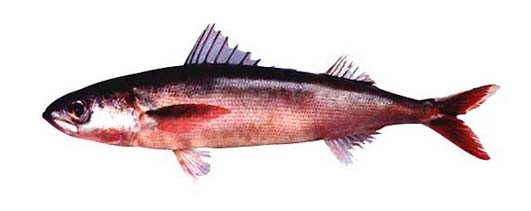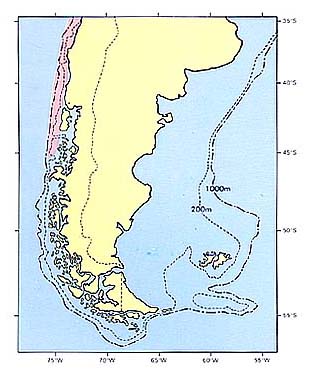ハチビキ科
- HOME
- デジタル図鑑
- パタゴニア海域の重要水族
- 硬骨魚綱 スズキ目
- ハチビキ科
ハチビキ科(Emmelichthyidae)

80 フンボルトハチビキ(Hunboruto-hachibiki)
Emmelichthys nitidus cyanescens (Guichenot, 1848)
特 徴:
背鰭13棘,9~10軟条,臀鰭3棘,10軟条,胸鰭22~23軟条,腹鰭1棘,5軟条,鰓耙数9~11+1+27~31=37~43。頭長は体長の26.6~27.7%,眼径は5.5~6.5%,体高は19.7~22.4%,体幅は13.5~15.0%,吻長は7.3~8.0%,両眼間隔は7.0~7.5%,上顎長は10.8~11.2%,尾柄高は6.1~6.9%,胸鰭長は20.7~21.5%,腹鰭長は12.8~15.5%,第1背鰭高は11.5~13.5%,第2背鰭高は8.5~9.6%,臀鰭高は9.5~10.5%。体は延長し,わずかに側扁し,亜円筒形を呈する。頭は小さく,体長は頭長の3.5~4.0倍。頭は吻端と両顎を除いて,種々の大きさの鱗でおおわれる。鼻孔は一対で,小さく,前鼻孔は卵円形で後鼻孔は三ケ月形。口は中庸で,著しく伸出可能。主上顎骨は幅広く,小鱗で完全におおわれるが,涙骨にはおおわれない。よく発達した前上顎骨が主上顎骨の背縁に位置し,幅広い上方突起とよく発達した中央背方突起を備える。大きな吻軟骨が発達し,前上顎骨の上方突起に沿って上下し,口の伸出,収縮を可能にする。数本の微小歯が下顎にあるが,上顎,鋤骨,口蓋骨および舌には歯がない。眼は大きく,頭長は眼径の4.3~4.6倍。主鰓蓋骨後縁に弱い棘がある。鰓腔後縁部に2つの顕著な突起がある。両眼間隔域は平坦で,その幅は吻長とほぼ等しい。吻の前端の背中線上に角張った欠刻があり,それが左右の前上顎骨の縫合部上の肉質突起を収める。背鰭と臀鰭の最後の鰭条は伸長する。鱗は弱い櫛鱗で脱落し難い。側線は単線でほぼ直線状で,腹縁より背縁近くを走る。鱗状の腹鰭間突起がある。
分 布:
チリ沖およびファン フェルナンデス諸島。
備 考:
本亜種とE. nitidus nitidusの違いは側線鱗数に最もよく現われている:100~105対87~89(Heemstra and Randall, 1977)。
(中村 泉)
Material examined:
8 from Chile (294.6-342.0 mm SL), FAKU CP 426, 516, 517, 625, 637-640.
Description:
D ⅩⅢ, 9-10; A Ⅲ, 10; P1 22-23; P2 Ⅰ, 5; GR 9-11+1+27-31=37-43. HL 26.6-27.7% of SL; ED 5.5-6.5; BD 19.7-22.4; BW 13.5-15.0; SN 7.3-8.0; IO 7.0-7.5; UJ 10.8-11.2; CP 6.1-6.9; P1L 20.7-21.5; P2L 12.8-15.5; D1H 11.5-13.5; D2H 8.5-9.6; AH 9.5-10.5.
Body elongate, slightly compressed (subcylindrical). Head small, 3.5-4.0 times in SL. Head covered with various sized scales except an anterior part of snout and both upper and lower jaws. Nostrils small, anterior nostril oval and posterior nostril crescent. Mouth moderate in size, extremely protrusible. Maxilla large, wide, completely covered with scales and not covered by rachrymal. A well developed supramaxilla along dorsal margin of maxilla. Premaxilla with a broad ascending process and a distinct middorsal process. A large rostral cartilage connected to ascending process of premaxilla which slides forward or backward along median dorsal ridge of ethmoid when mouth retracted and protruded. A few minute teeth on jaw anteriorly, upper jaw toothless. Toothless on vomer, palatines and tongue. Eye large, 4.3-4.6 times in head. A blunt spine on posterior part of opercle. Two distinct protuberances on posterior margin of gill-cavity. Interorbital region flat, its width nearly equal to snout length. Anterior edge of snout at dorsal midline with a distinct squarish notch which receives a fleshy pad at premaxillary symphysis. Last dorsal and anal fin rays prolonged. Scales weak ctenoid, not deciduous. Lateral line fairly straight, running nearer to dorsal profile. Scaly interpelvic process present.
Distribution:
Chile and Juan Fernandez Islands.
Remarks:
The only difference between E. nitidus cyanesces and E. nitidus nitidus is the slightly higher number of lateral-line scales in the former (100-105) versus lower number in the latter (87-89) (Heemstra and Randall, 1977).
(Izumi NAKAMURA)

Distribution of Emmelichthys mitidus cyanscens in Patagonia.

Mouth protruded.
- 1